*This post may contain affiliate links. Read more »
Even people who think they hate okra love this Punjabi Bhindi Dry Recipe! This cooking method proves once and for all that okra can be absurdly delicious and NOT slimey. There's a good reason why over 500 recipe testers made, and continue to make and adore this banger!


Enter your email & I'll send it to your inbox. Plus, get great new recipes from me every week!
By submitting this form, you consent to receive emails from Cinnamon Snail.
Punjabi Dry Bhindi combines the aromatic spices of cumin, coriander, and channa masala, along with the heat of green chilies, to create a complex blend of flavors. Grated ginger, dry grated coconut, coriander leaves (cilantro), and a touch of lemon juice balance and enliven the perfectly cooked okra.
You can serve it with hot, perfectly cooked Amritsari Kulcha, with a side of dal tadka, masoor Dahl, or my 100% vegan butter chicken that's made from my juicy, tender seitan. Want another great veggie sabji to serve with it? The ridge gourd curry on my blog is BANGIN’ and will make you so happy to be veg!
The secret to perfecting this recipe lies in the careful balance of spices and the cooking technique to ensure the okra remains tender, flavorful, and free from sliminess. Following a few essential steps, such as choosing fresh okra, properly drying it, and avoiding overcrowding in the pan, guarantees a satisfyingly crisp and delicious outcome.
Grab a pan, because greens are the “meat” of a vegetarian diet, and you are about to fall head over heels in love with this Punjabi Dry Bhindi!
Jump to:
🥰Why you'll adore this bhindi dry recipe
🤢Non-Slimy Okra: One common concern when cooking okra is its tendency to become slimy. Don't dismay. I've fine tuned this recipe to make sure your okra is perfectly cooked and free from excess slime.
✊Vegan AF: Like all of the vegan recipes, this okra recipe is made without a single animal based ingredient and contains no cholesterol.
🧘♀️Easily made sattvic: The dish can be made sattvic by simply omitting the onions. This modification allows the dish to be suitable for bhoga offerings, or for individuals who prefer meals free of onions and garlic. Check out my sattvic vegan cooking class, or entire library of sattvic recipes to learn more about this cooking method and way of life.
👉Gluten-free: I know you hate gluten so much that every time you see a slice of bread, the veins in your neck bulge up, your face turns red, and you punch through a sheetrock wall. Well, no worries here, because this okra dish is one of the gluten-free vegan recipes your whole family will love!


Curry in a Hurry - Vegan Indian Recipe Club! 🍲💌
This 6-day program is 100% FREE. Let me help you to master plant-based Indian cooking!
🚚How did Punjabi style bhindi become so popular?

I remember my first time traveling through Punjab, stopping late at night at a dhaba for dinner and being blown away by the atmosphere and food. Dhabas are traditional roadside eateries that have become an integral part of the Punjabi food culture. These rustic truck-stop eateries are known for serving hearty, flavorful, and soul-satisfying meals, often characterized by generous portions and bold flavors. I’m going to be honest here when I say, I have had some of the best, as well as some of the worst meals in my life, served at Punjabi Dhabas. The great pure-veg ones are far and few between, and many dhabas serve animal flesh (which is terrible…) and because of the dusty Punjabi roads, they can sometimes be a little filthy.
Punjabi dhabas offer a diverse range of dishes, showcasing the region's agricultural abundance and love for robust flavors. Expect to find a plethora of vegetarian and non-vegetarian options, including classics like rajma chawal, tandoori chicken, dal makhani (creamy, buttery lentils), veg biryani, and of course, bhindi. These dishes are prepared using traditional cooking methods, such as slow-cooking in clay tandoors or handi (traditional pots), which infuse them with a distinct smoky flavor and tender texture.
The charm of dining at a Punjabi dhaba lies not only in the delectable food but also in the lively ambiance and warm hospitality. Dhabas often feature vibrant decor (like wacky neon lighting and larger-than-life Bollywood-style signage), rustic seating arrangements, and a bustling atmosphere that reflects the vibrancy of Punjabi culture. It is not uncommon to see families, friends, tuck drivers, and travelers gathering at dhabas to enjoy a hearty meal together, creating a sense of community and camaraderie.
🌶️ Ingredients for this Punjabi okra recipe
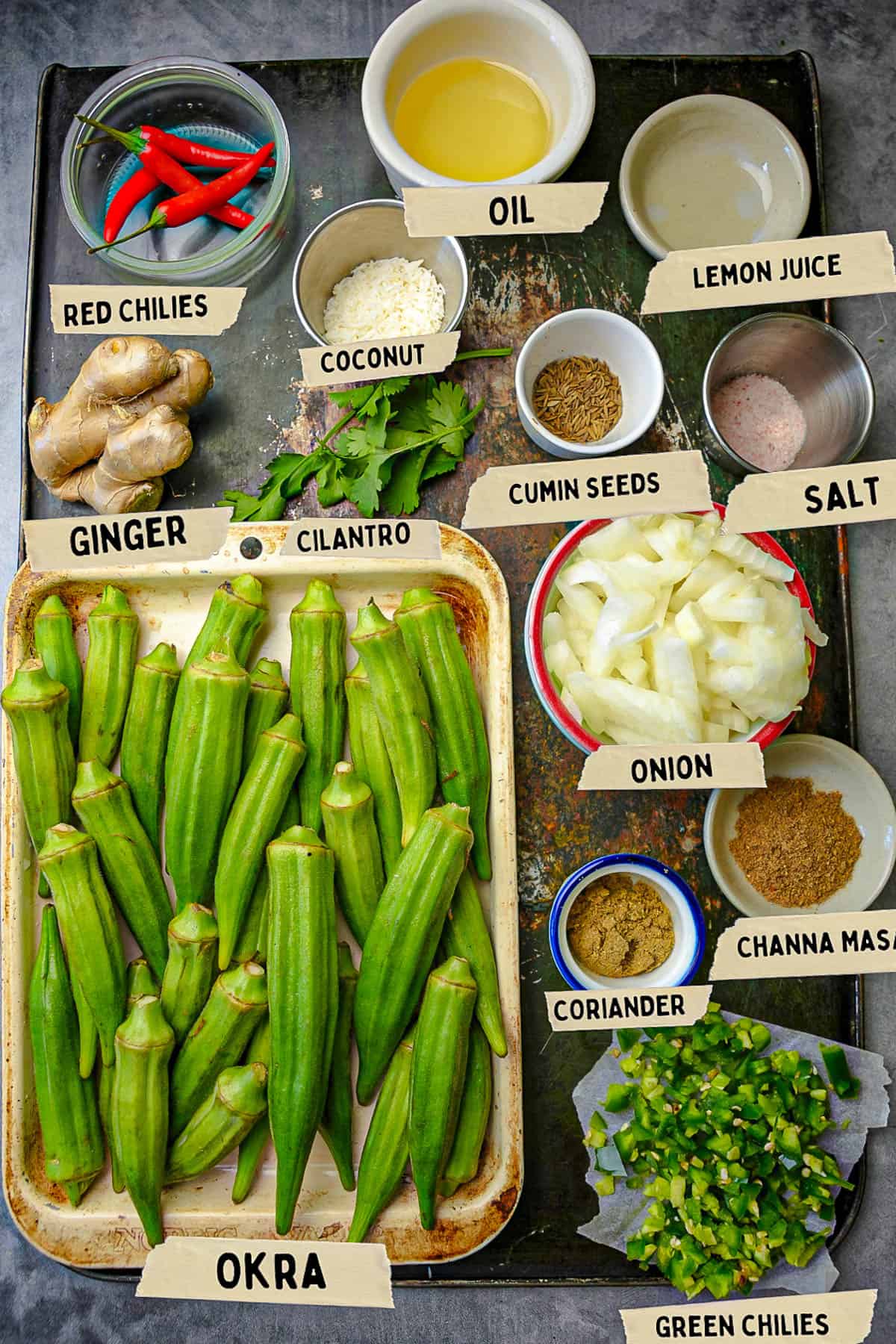
Hari Mirch
Indian green chilies, known for their vibrant heat, are commonly used in Indian cooking to add spice and depth to dishes. They bring a fresh, fiery flavor to the Punjabi Dry Bhindi. They are the same kind you would mix with achar masala to make green chili pickle.
If Indian green chilies are not accessible, you can substitute them with other green chili varieties such as serrano peppers or jalapeños, or use red bird’s eye chilies (aka Thai chilies), adjusting the quantity based on your desired level of spiciness.
Channa Masala
Chana masala is a popular spice blend used in Indian cuisine, specifically in chickpeas (chana) dishes. I use it in my vegan chana masala curry, and also my vegan butter chicken recipe. It imparts a robust and slightly tangy flavor to the dish. If channa masala powder is not available, you can substitute it with a combination of ground cumin, coriander, a pinch of fenugreek powder (kauri methi), and a pinch of amchur (dried mango powder) for a similar flavor profile. You can also substitute garam masala for a more warming flavor.

Get my fave cumin seeds for free!
Using this link, add the wild mountain cumin to your cart, spend at least $15 on some of the other absurdly good spices from Burlap & Barrel (they all seriously slap) and the bottle of this bangin' wild mountain cumin becomes FREE, and you will love it so much.

Lemon
Lemon juice helps perk up the flavors and deglaze the pan, picking up more of the pieces and flavors that would otherwise be left behind in the pan. Alternatively, you can replace the lemon juice with lime juice or a splash of white vinegar. Adjust the quantity of juice according to your taste preferences, ensuring a balance of tanginess in the dish.
*See the recipe card at the bottom of the page for exact quantities, nutritional info, and detailed cooking directions.
🙋♂️ How to select the best okra
There are two ways to hate okra - either slimy or woody and fibrous. Here are some ways you can ensure you pick out the perfect okra for cooking:
- Look for vibrant green color: Choose okra pods with a bright, vibrant green color. Avoid okra that appears dull, yellowish, or has dark spots, as it may indicate age or lack of freshness.
- Medium-sized pods: Smaller to medium-sized okra pods are generally more tender and less fibrous than larger ones. They are ideal for achieving a desirable texture in the Punjabi Dry Bhindi.
- Check for firmness: Gently squeeze the okra pods to check for firmness. They should feel firm and crisp, indicating freshness. Avoid okra that feels soft or limp, as it may be overripe or lesser quality.
- Examine the stems: The stems of the okra pods should be green, fresh-looking, and not wilted or dried out. Healthy stems indicate that the okra has been recently harvested and is in good condition.
- Avoid blemishes and scars: Inspect the okra for any blemishes, bruises, or scars. Choose pods that are smooth and free from visible damage, as they are more likely to be fresh and have a better texture when cooked.
This recipe works great with standard okra or “desi okra”. Desi is a modern Hindi term that means “country” (coming from the Sanskrit word deśa (location), which you see pop up in the names of many places that end with -desh like Bangladesh, Radhadesh, and Brahmadesh). Over time, desi has come to mean “Indian” to most people. Anyway, the desi okra tends to be more slender, lighter green, and has smaller seeds than the American variety. Both varieties work great in this recipe, as long as the above five conditions are met.
📖 How to make this bhindi dry recipe
Here ya go. Follow this photographic guide for making dry bhindi, or you can follow along with the easy-to-print recipe card towards the bottom of this page.

Step 1
Start by giving the okra a thorough wash under cold running water. This will help remove any dirt or impurities. After washing, use a kitchen towel or paper towels to pat the okra dry.
Trim off the small stems from the okra and discard them. Then, cut the okra into 1 cm sections. Cutting the okra into equal-sized pieces ensures even cooking. You can slice the okra into slightly smaller pieces if you prefer a shorter cooking time and a crunchier texture.
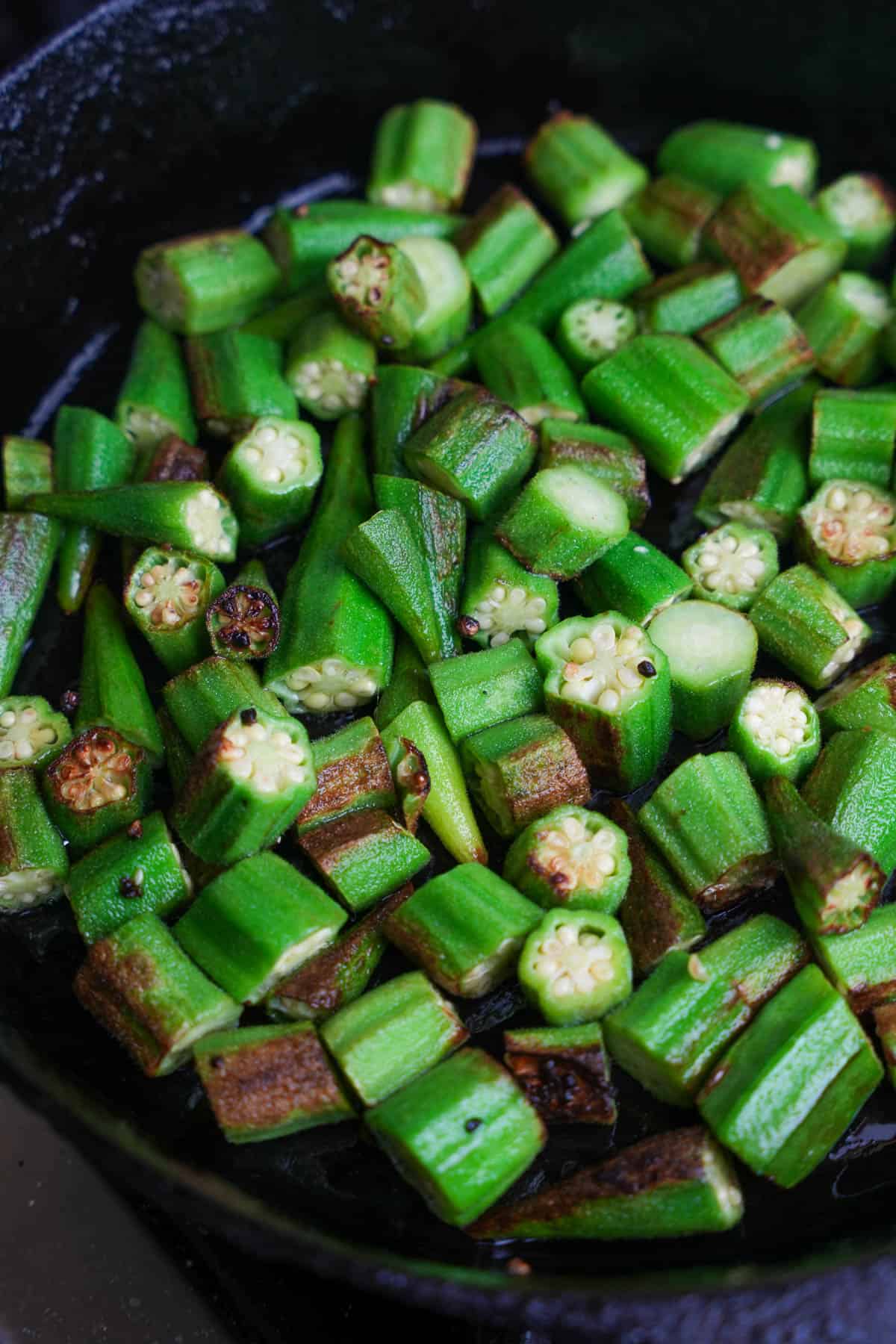
Step 2
Heat the oil in a large skillet or frying pan over high heat. After 60 seconds, once the oil is hot, carefully add the sliced okra to the pan. Fry the okra for approximately four minutes, flipping it gently every minute. This flipping technique prevents excessive stirring, which can lead to sliminess. The aim is to achieve a crisp texture around the edges.
Avoid overcrowding the pan with too much okra at once, as it may cause uneven cooking. It's better to cook in small batches.
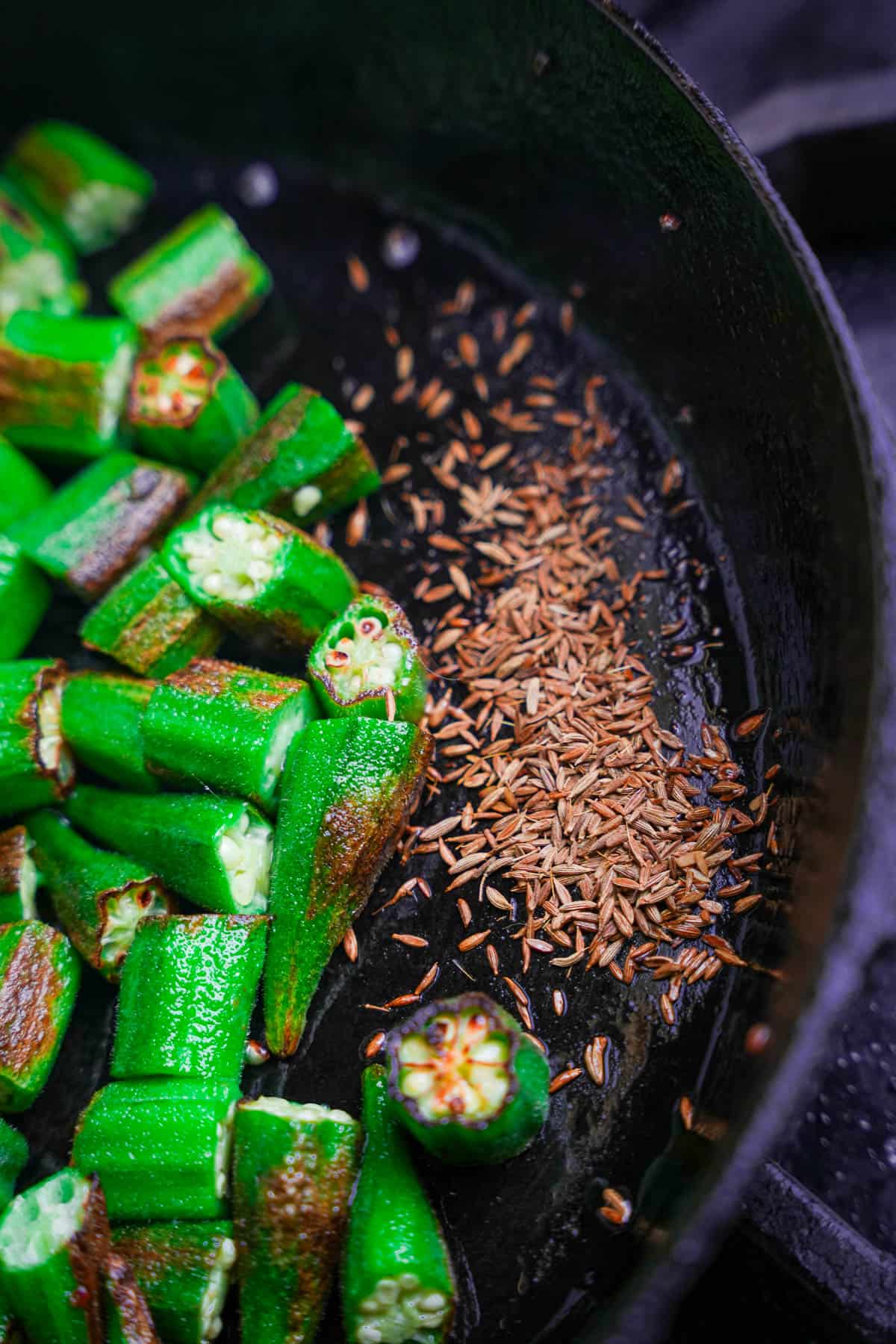
Step 3
Add the cumin seeds (jeera) to the hot oil and let them sizzle for about 30 seconds until they release their aromatic fragrance.
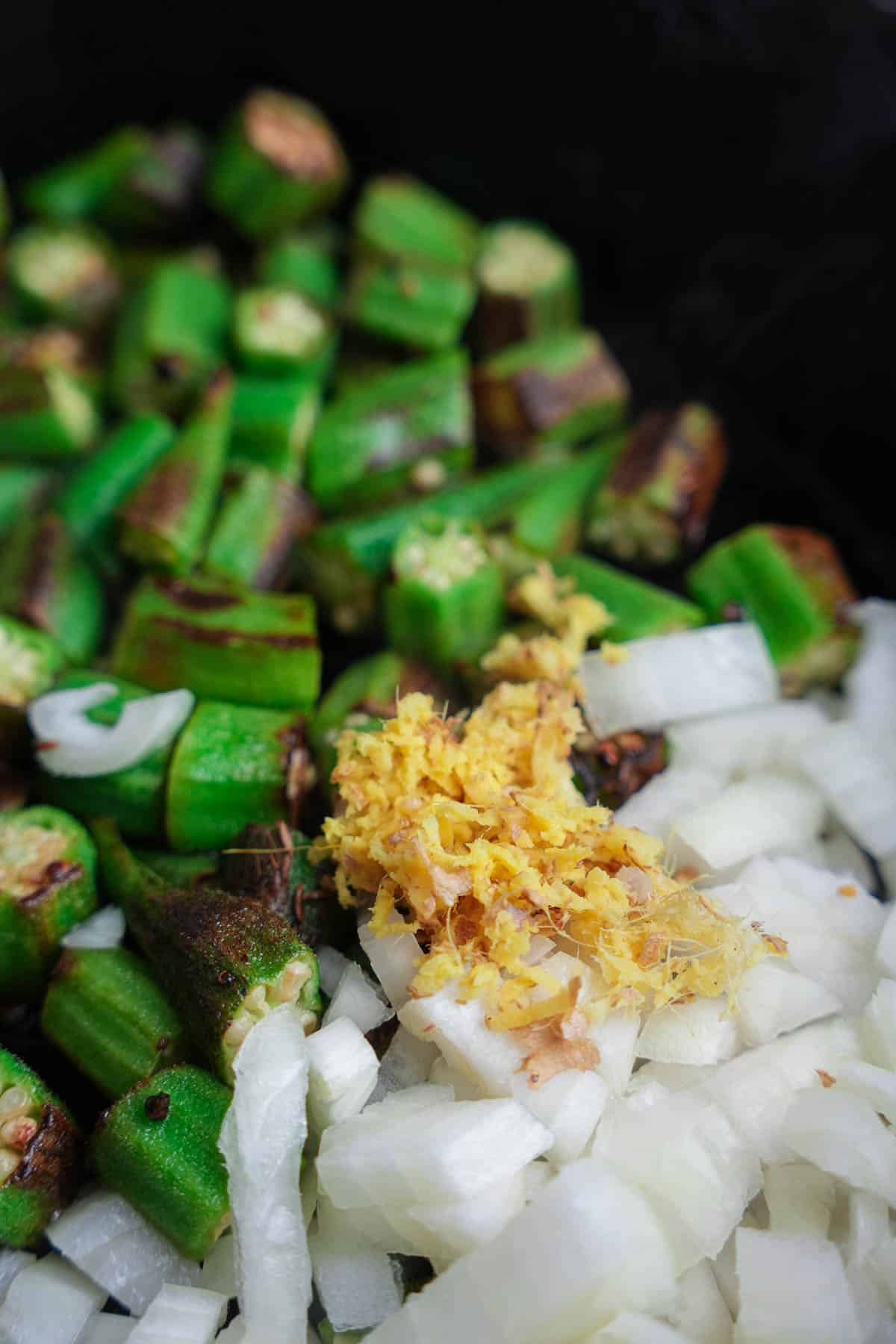
Step 4
Add the diced onion and grated ginger to the pan. Sauté them for approximately three minutes until the onion turns translucent and lightly golden brown.
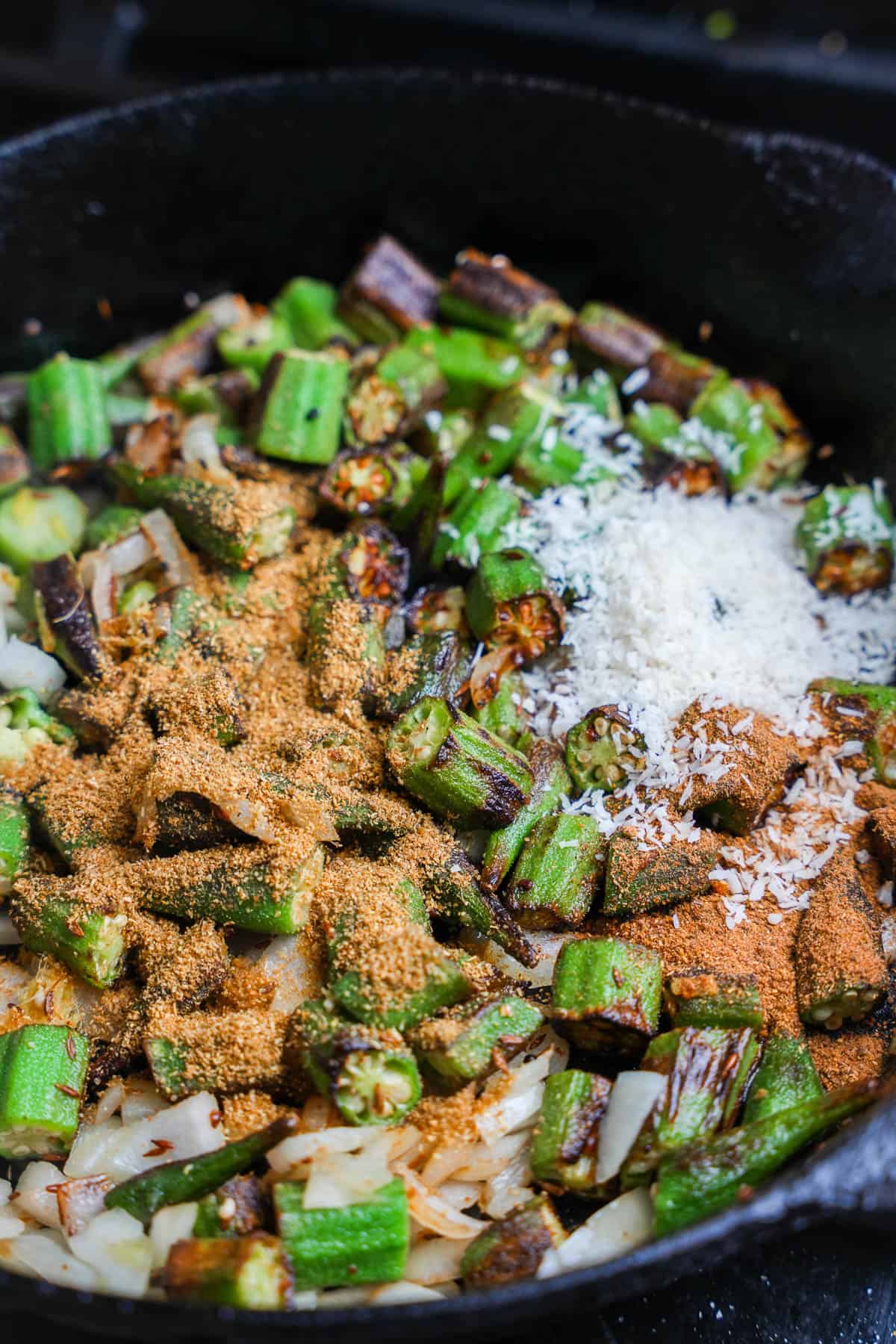
Step 5
Once the onion and ginger are cooked, sprinkle the coriander powder, channa masala powder, and dry grated coconut evenly over the okra. Stir everything together to ensure that the spices coat the okra uniformly. Adjust the spices according to your taste preferences. You can also add a pinch of turmeric powder for extra color.
Cover the pan with a lid and cook the okra on low heat for 6-8 minutes. This gentle cooking process allows the okra to soften and cook through, infusing it with the flavors of the spices.

Step 6
Remove the lid and add the minced green chilies, lemon juice, and salt. Adjust the amount of green chilies based on your preferred spice level.

Transfer the contents of the pan to an attractive serving dish. Garnish the dish with fresh cilantro leaves and thinly sliced fresh red chilies to add a pop of color and additional flavor.
🍽️Serving Ideas
Bhindi is a versatile dish that complements a variety of Indian meals. It pairs perfectly as a simple subji alongside kala chana or chana dal or coconut rice. For a complete and satisfying meal, consider adding sides such as onion bhaji, medhu vada, arhar dal tadka, red lentil dahl, and crispy flaky pan-cooked breads like Kerala-style parotta.
🔥Serve it with your favorite Indian pickles such as amla, green chili, spicy cucumber, or carrot pickles. Or top it with delicious, fiery shatta.
Are you looking to level this meal up with other delicious veggies? You can serve bhindi with Kerala-style aviyal, saag aloo, parval curry, makhana subzi, coconut milk gourd curry, lauki subzi.
You can even garnish the bhindi with some masala phool makhana for a crunchy, spicy contrast.
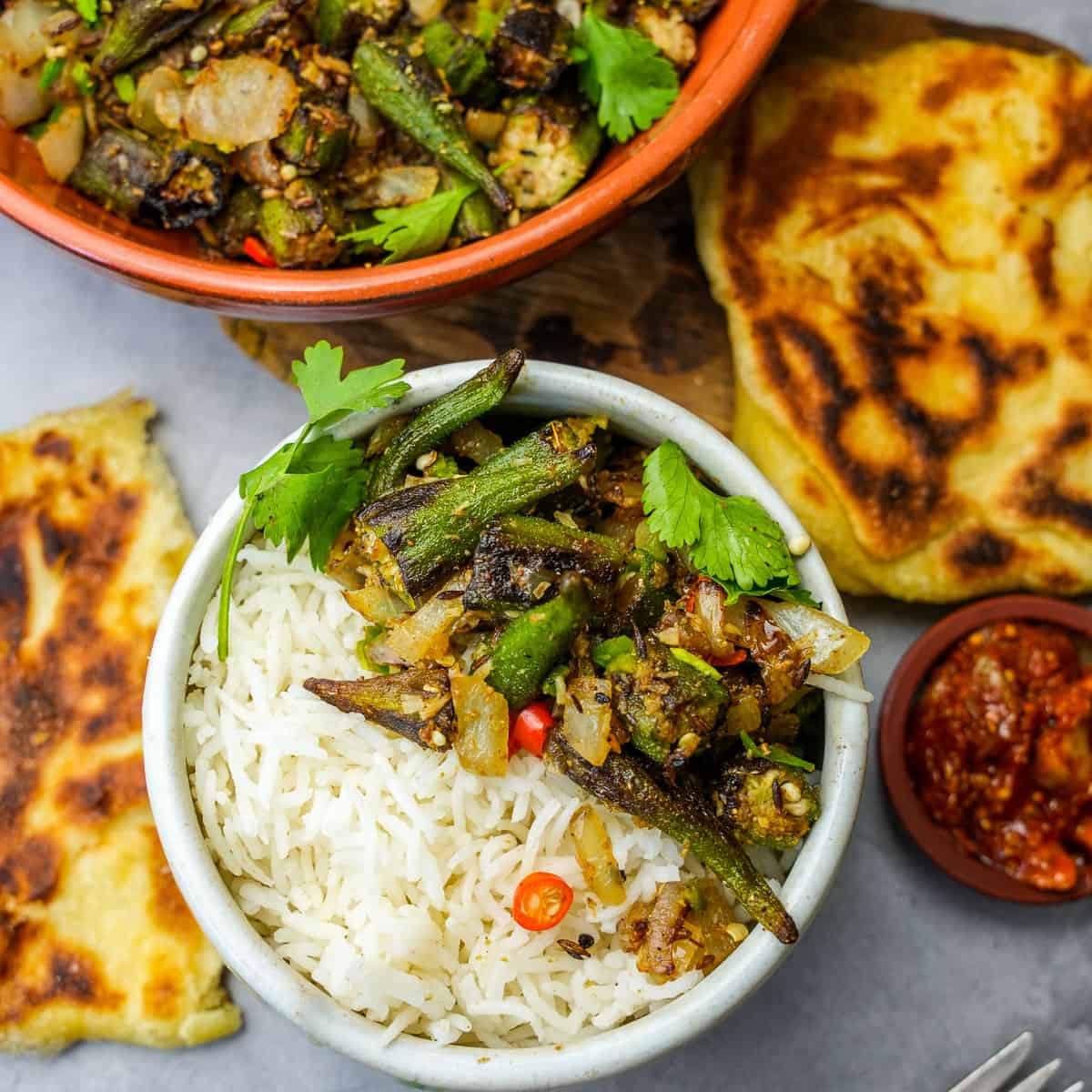
🤷♀️FAQ
While commonly referred to as a vegetable, bhindi (also called lady’s finger, or okra) is scientifically classified as a fruit. In botanical terms, a fruit is the mature ovary of a flowering plant that contains seeds. Okra, when allowed to mature and fully develop, produces elongated pods that house numerous seeds. These pods arise from the flower of the okra plant and serve as the fruit of the plant.
Apart from its surprising classification, okra is prized for its nutritional value. It is an excellent source of vitamins, particularly vitamin C and vitamin K. Vitamin C acts as an antioxidant, supporting the immune system and promoting overall health. Vitamin K is essential for proper blood clotting and contributes to bone health. Okra is also a good source of magnesium, a mineral that plays a crucial role in various bodily functions, including energy production, muscle function, and bone health
The term bhindi specifically refers to okra in Hindi. The etymology of the term can be traced back to its Sanskrit origin, where it is derived from the word bindīka In Sanskrit, bindīkau refers to a small seed or a kind of plant. This word uses the same dhatu (verbal root) root as the word bindu meaning dot (such as the dot which represents anusvara, making the m/n sound).
Over time, this Sanskrit term underwent linguistic transformations as it passed through different languages and cultures. In Hindi, it eventually became bhindi, which denotes the okra plant and its edible pods. The name bhindi is widely used in the Indian subcontinent and has become commonly associated with okra in various regional languages spoken in India.
Once the Punjabi Dry Bhindi is cooked, allow it to cool to room temperature for 20 minutes.
Transfer the leftover bhindi to an airtight container or a sealable plastic bag.
Place the container in the refrigerator and store it for up to three days.
🔥Stovetop Reheating Instructions
Take out the refrigerated bhindi from the storage container and transfer it to a skillet or frying pan.
Heat the skillet over low-medium heat and add a splash of water or oil to prevent sticking. Cover the pan while it cooks for five minutes so the okra gets heated all the way through.
❤️ My favey dishes to serve with this bhindi dry recipe:

Punjabi Bhindi Dry Recipe
Ingredients
- 12 oz. 340 g. okra
- 3 tablespoons canola oil vegetable oil, or sunflower oil
- ½ teaspoon jeera cumin seeds
- 1 small yellow onion diced
- 1 teaspoon grated fresh ginger
- 1 teaspoon coriander powder
- 1 teaspoon chana masala
- 1 tablespoon dry grated coconut
- 4 teaspoons minced green or red chilies
- 1 teaspoon lemon juice
- ½ teaspoon salt or to taste
To garnish:
- Fresh chopped cilantro leaves
- Thinly sliced fresh red chilies to taste
Instructions
- Thoroughly wash the okra, and pat it dry with a kitchen towel or paper towels.
- Cut off and discard the small stems of the okra, and cut the okra into 1 cm. sections.
- Heat the oil in a large skillet or frying pan over high heat.
- After 60 seconds, when the oil is hot, add the sliced okra, and fry it in the hot oil for four minutes until crisp around the edges. Flip the okra about every minute, without stirring it excessively so it doesn’t become slimy.
- Add the cumin seeds (jeera) and let them sizzle for about 30 seconds until they become aromatic.
- Add the diced onion and grated ginger to the pan. Sauté them for about three minutes until the onion becomes translucent and lightly golden brown.
- Once the onion and ginger are cooked, add the coriander powder, channa masala powder, and dry grated coconut over the okra. Mix everything together so that the spices are evenly distributed.
- Cover the pan and cook the okra on low heat for about 6-8 minutes. This will allow the okra to soften and cook through.
- Remove the lid and stir in the minced green chilies, lemon juice, and salt.
- Place the contents of the pan into an attractive serving dish and garnish with fresh cilantro leaves and finely chopped fresh red chilies to taste.
Notes
- Choose fresh okra: Select fresh okra that is firm, vibrant green, and free from bruises or blemishes. Fresh okra tends to be less slimy than older or wilted okra.
- Thoroughly dry the okra: After washing the okra, make sure to pat them completely dry using a kitchen towel or paper towels. Moisture on the okra can contribute to increased slime during cooking.
- Trim the ends properly: Trim off both ends of the okra before slicing them. Removing the stem end reduces the chances of excess slime being released while cooking.
- Avoid overcrowding the pan: Cook the okra in batches or use a large enough skillet or frying pan to ensure that the okra is spread out in a single layer. Crowding the pan can lead to steaming instead of sautéing, which can result in slimy okra.
- Cook on high heat: Start cooking the okra on medium-high heat to quickly sear the exterior and seal in the moisture. This helps prevent excessive slime formation. Avoid cooking over medium heat, especially in the initial cooking phase.
- Do not cover the pan initially: Allow the okra to cook uncovered for the first few minutes. This helps evaporate any excess moisture and reduces the chances of sliminess.
- Avoid excessive stirring: While cooking, avoid stirring the okra too frequently, as this can break down the vegetable and release more slime. Stir occasionally and gently to ensure even cooking.
- Use acidic ingredients: Adding acidic ingredients like lemon juice or tomatoes can help reduce the sliminess of okra. In the provided recipe, the lemon juice helps balance the flavors and minimize slime.

Enter your email & I'll send it to your inbox. Plus, get great new recipes from me every week!
By submitting this form, you consent to receive emails from Cinnamon Snail.

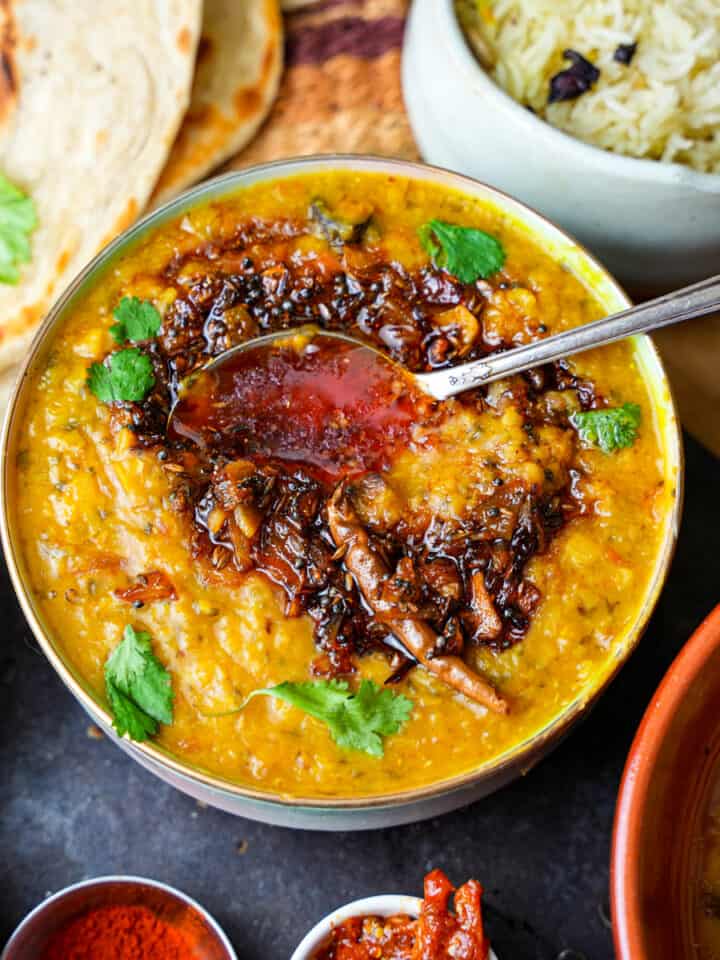
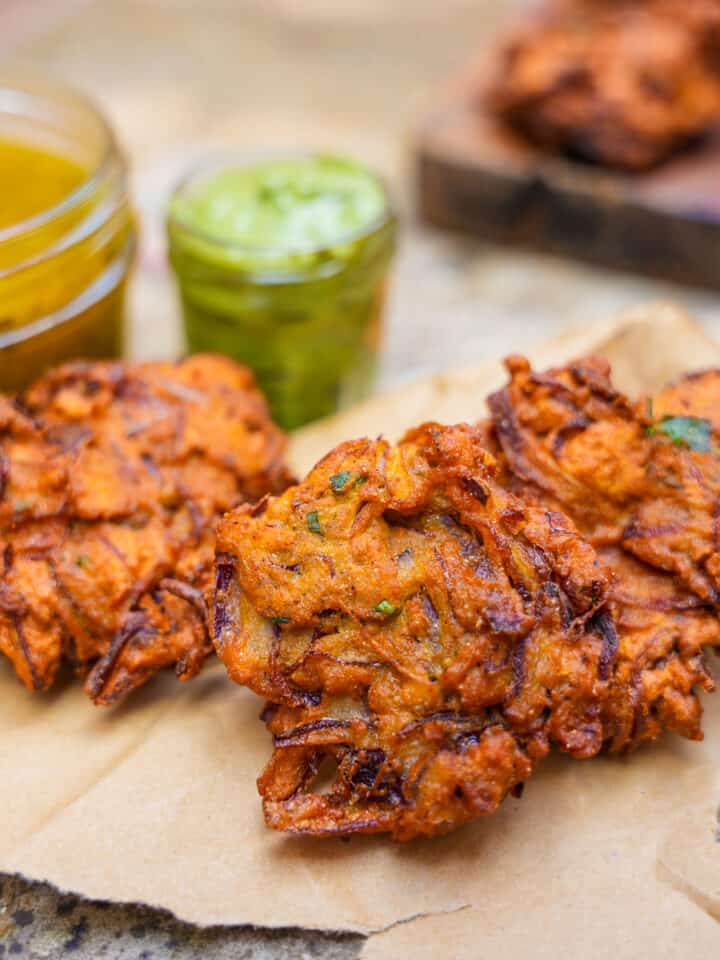
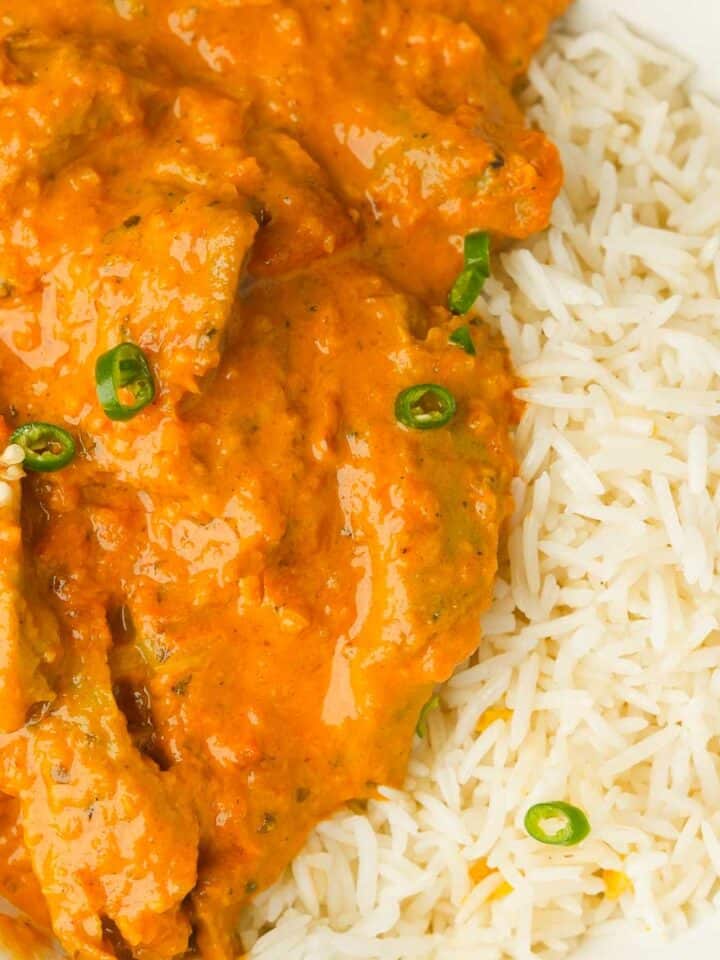







Traci Greenamyer says
What if you don’t have cumin seeds can you use ground cumin?
Adam Sobel says
Absolutely!
Paige Davis says
I made this along with Adam’s Aloo Gobi the other night. I was very nervous for fear of having a slimy result, but Adam’s recipe was so thorough that I had the confidence to try, even though my fiancé said he did not like Okra.
I thought it was delicious, and will definitely be making this again. My fiancé said it was the best okra he had ever had, and next time I will be adding all the bells and whistles as Adam suggests, like the pickled things on the side. But considering how exhausted I was, I think all the food I made turned out very well. It is a testament to Adam’s skill as a chef and an author and an all-around human being that even when conditions aren’t perfect, your food can be if you follow his careful directions. I have tried many of his recipes and have never been disappointed.
Adam Sobel says
Awwww. Thanks Paige. I am so glad you made and loved this one too. Okra is probably my wife's fave green veggie, so we eat it often!
Lisa says
I made this dish for dinner tonight. For very little effort you get amazing flavor. The okra came out tender without any hint of slime. Served with a lentil dish and steamed greens. My husband who is not an okra fan loved it. Will be making this again while okra is in season.